Custom Software Development: The Ultimate Guide
Ranging from tips on when to choose custom software to what to expect during development, this custom software development guide has it all.
Don’t feel like reading? Listen to our guide as a podcast, powered by NotebookLM technology.
In the age where industry landscapes are ever changing, businesses must be able to continuously improve their processes and infrastructures in order to thrive. To effectively adapt to changing trends and product offerings, businesses require the ability to quickly pivot and adjust with their market’s needs and wants. Through custom software development, businesses are able to offer their customers a unique user experience which differentiates themselves from competitors in their market.
In addition to the custom functionality and flexibility custom software is able to offer, it can also save time and money for growing companies and their IT infrastructures. As opposed to custom software, off-the-shelf software often lacks the ability to integrate with legacy systems, which can result in significant costs associated with upgrading integration infrastructure capabilities.
Upon completion of reading this custom software development guide, you will have a full understanding of the benefits of custom software, what to look for when hiring a custom software development company, what to expect and how to ensure success during the custom software development process.
01
Chapter 01
When To Choose Custom Software Development
When a business needs software for its operations, there are two general paths it can take: buying an off-the-shelf solution or developing a new product that meets its unique requirements.
Custom software development is a process that encompasses the design, build, integration, scaling and upgrading of software solutions in order to address a specific business’s unique needs, objectives and goals.
The Advantages Of Custom Software Development
Custom software development can help a company to improve its customer interactions, optimize internal business processes and streamline their collaboration with partners. Here is a look at some of the specific reasons many businesses opt to invest in custom software development.
It Meets Your Business’s Specific Needs
Every company is unique and has its own set of needs and issues that need to be addressed. Some businesses have specific security regulations that they must adhere to, while others may be seeking to offer consumers specific functions that cannot be found in offerings from their competitors. Tailored products are made with your business in mind, and new functionality can easily be added as your business scales and evolves.
Custom software can be developed for companies across all industries, from healthcare and banking to retail and manufacturing.
You Can Automate Manual Operations
A company’s workflow can be interrupted significantly by carrying out repeated manual actions. Automating manual operations that are encountered frequently in your business can save time and expenses, while boosting the efficiency of your workforce.
Your Business Can Save Money
Although an off-the-shelf solution may seem cheaper initially, it could end up costing more money in the long run. Some ready-made solutions will have licensing fees and other fees that need to be paid on a monthly or yearly basis, and it may not be able to keep up with changes to your company.
If you need to rely on several different off-the-shelf software offerings to meet your needs, the expenses can really add up over time. Moreover, when you get custom software, you do not need to pay for unnecessary features that your business will never use.
You Can Control Security Better
Cyberattacks are on the rise, and hackers often aim their efforts at major off-the-shelf software programs. Because they are designed with wide usage in mind, the source program code is easier to hack on ready-made software than custom varieties.
Custom software is a lot harder to attack because most tailored offerings are not publicly accessible. In addition, the specialized security and encryption used by bespoke solutions can make the products safer.
IBM reports that the most targeted industries for hacking[1]https://www.forbes.com/sites/stevemorgan/2016/05/13/list-of-the-5-most-cyber-attacked-industries/#2e3ca8ea715e are healthcare, finance and manufacturing. The reputational damage and lost money that could arise from the theft of personal data and intellectual property could be impossible to recover from, so this is an area that is well worth investing in from the outset.

Discover potential website vulnerabilities and server configuration issues with Pentest Tools.
Updating Legacy Systems
To help you reach greater levels of efficiency, custom software developers can recode legacy solutions with modern technology to extend their functionality and bring them up to date as needed. This can also be achieved through application modernization.
Integration With Other Software & Tools
Many businesses already employ specific software programs for certain tasks that they wish to continue using, and custom software can take that into account and be developed with other company tools in mind. This helps avoid the integration issues that often arise when companies try to use off-the-shelf solutions in conjunction with one another.
Custom Software Development vs. Off-The-Shelf Software
Below is a list of comparisons and what your business should consider when choosing between custom software and off-the-shelf software.
Custom Software
Off-The-Shelf
Problem
The issues you need to solve are unique to your business.
Everyone in your industry has the same challenge.
You have several existing systems that you’ll need to integrate with the new software.
No system integration is needed.
You use internal processes that make your company unique or better at what you do than your competitors.
You operate in a very standard way that is identical to similar companies.
The software will need to support internal users and interaction with outside parties such as suppliers, members or customers.
The software will be for internal use only.
Your company has disparate systems holding important data or creating work that is redundant.
You do not have any disparate systems.
You believe technology can be used to give your business a cost, time or market advantage over the competition or better engage your customers.
You do not think technology can be a major differentiator for your company.
Custom Software
Off-The-Shelf
Ownership / Control
It would be very difficult to modify your internal processes to make them work within the limitations of a tech platform that was not designed with your organization’s needs in mind.
Your processes are very flexible and can adjust to any solution.
Your company has internal IT managers or other experts who thoroughly understand the challenges you face.
Your company does not possess internal expertise in the technology sphere.
Custom Software
Off-The-Shelf
Flexibility
Your organization’s existing software solutions are limiting your business.
You have no complaints about the software your company uses and do not see any room for improvement.
Your business is expanding significantly.
Your company is not experiencing growth and none is expected in the future.
Your off-the-shelf software providers have forced you into upgrades in the past when you have tried to tailor their offerings to your organization.
You have never needed to tailor off-the-shelf solutions to meet your company’s needs.
Your company is constantly impeded by software bugs or missing features in your current software products.
The software you are currently using does not cause any frustration or experience technical problems.
You place a high value on the ability to easily modify your workflows in the future to adjust to how your business evolves.
You do not value flexibility in software.
Custom Software
Off-The-Shelf
Budget / Cost / Timelines
You would rather pay more money up front to get exactly what you need out of software than an endless monthly fee for a solution that is only adequate.
Instead of paying for a tailored solution up front, you would prefer to pay a moderate monthly fee indefinitely and accept any challenges a non-tailored solution might pose.
The software you seek will solve a problem for a base of more than 20 users.
Fewer than 5 users need to use software for the issue at hand.
You need a software solution as soon as possible, yet you appreciate the value of doing things in the right order.
You need to install software for the issue immediately, even if it is not a full solution.
Popular Custom Software Applications To Develop
Choosing the best type of custom software application depends on your needs and what industry your business works within. An experienced custom software application development company can help you decide which custom software application to acquire.
Below are some of the most popular custom software applications to develop.
Advanced Web Applications
Advanced web applications can reduce costs, are highly responsive and do not need to be installed or updated by individual users. Scalable and highly accessible, these options provide high levels of efficiency.
View Advanced Web ApplicationsEnterprise Applications
Enterprise applications integrate into existing departmental software into one user-friendly interface to better manage and share data across the company and are built to grow with the company.
View Enterprise ApplicationsSaaS Applications
SaaS applications are developed with a user-friendly interface which promotes sales, integrates with almost any platform and are also highly secure to prevent costly data breaches.
View SaaS ApplicationsMobile Applications
As a staple of custom software application development, mobile applications offer the most efficient user interface, are highly responsive across all types of mobile devices and developed to deliver the best possible experience for users in all kinds of industries.
View Mobile ApplicationsHIPAA Applications
HIPAA compliant applications simplify and streamline processes, provide patients a personalized and user-friendly experience and abide by strict government guidelines under HIPAA.
View HIPAA ApplicationsE-Commerce Applications
E-Commerce Software Solutions allow an online store to be integrated into a company’s existing website so they can sell goods with a customized storefront, track payments and organize products with ease.
View E-Commerce Applications02
Chapter 02
How To Pre-Plan A Custom Software Development Project
Before beginning the search for a custom software development company, there are a few questions that need to be answered in order to receive a product which addresses your needs, the needs of your clients and aligns with the goals and objectives of your business.
By creating a pre-plan, you are able to accurately describe your vision of the software to the developers, identify potential integration issues and establish a budget which will align expectations and goals between stakeholders, developers and designers.
What Basic Functionality Will Your Software Perform?
At the heart of custom software development are issues that need solutions. For example, you may be looking to drive membership, improve the user experience or collect data to make better decisions.
Which Existing Systems Will It Integrate With?
One important topic that should come up during early discussions is which other tools the custom software needs to be integrated with, whether they are also custom-made solutions or are platform-based offerings such as customer relation management solutions, content management systems or enterprise resource planning solutions.
Which Devices & Operating Systems Will Your Software Run On?
The product specifications will also be determined at this stage. The main question is which devices and operating systems will be running the new software. However, the expectations for workflow and specific features will also be discussed.
Budget Planning
Unfortunately, there is no way of knowing at the beginning of a project just how much it will end up costing. The cone of uncertainty[2] (Figure 2.1) is at play here because no two projects will involve the same requirements, people, technology, priority, constraints and business context.

Nevertheless, good software development companies understand that stakeholders need to know how much the project is going to cost the company from the outset. They may be able to provide an estimate, which they can then update as they go along to give a more accurate figure. All projects start out with a big degree of variability, but the cost becomes clearer as time goes on.
03
Chapter 03
How To Hire A Custom Software Development Company
Hiring the right custom software development company is one of the most important steps in the custom software development process and involves more than reading reviews and viewing portfolios.
It is worth putting some effort into finding a good custom software development company for your project. You will be working very closely together, so you will want a company that makes you feel completely at ease and confident.
Quality should be one of the top considerations. Although high-quality developers may come with a higher price tag, they could end up being the more economical option as you will be less likely to need to pay someone to rewrite broken code later. Moreover, higher-quality code is generally easier for future developers to update and maintain, which could keep costs down the line lower as well.
You will also want development teams who carry out an extensive quality assurance process to avoid bugs.
Cultural Alignment
Effective collaboration with stakeholders is essential for creating an end product that meets your needs. You will want to seek a company whose values align with yours to ensure everyone is on the same page.

Before hiring a custom software development company, take this company culture assessment by Inc. to get a better understanding of your company’s culture.
Team Options
There are several different options when it comes to how you work with experts to complete your custom software development project. Although you will find no shortage of people who are skilled in building software, you must first choose the right type of team.
Hiring A Technical Co-Founder
An experienced programmer, such as a senior software engineer, can be hired to serve as a technical co-founder who is fully devoted to building your software. This individual will handle all of the programming while you work on securing funding and creating a sales and marketing plan for the software.
This option is often used by those with a great idea for software who lack the technical know-how to make it reality, but it is not the best choice for businesses looking for productivity solutions. Moreover, while the individual will have a strong vested interest in succeeding, it comes at the price of compensating them with equity in your company. Another potential drawback is the longer time it takes for an individual to build software versus a team.
Pros
- Individuals who lack technical knowledge
- More time to secure funding & creating a sales and marketing plan
Cons
- Equity compensation Takes longer than hiring a development team
Building Your Own Custom Software Development Team
Your company could set up its own software development team, perhaps by bringing in a technical co-founder and several other technical team members working beneath the co-founder. This means you have access to a full team at all times, but it is not a cost-effective option by any means as it involves taking on several new employees.
It can be complicated further by the fact that there is a rather tight job market for software and quality assurance engineers, so it could take quite some time to form a good team.
Pros
- Access to a full team at all times
- Hand-selected team members
Cons
- Far from cost-effective
- Requires extra time to build a team
Hiring A Contractor Or Freelancer
A contractor or freelancer is similar to a technical co-founder in the sense that it involves a single point of contact, but unlike with a technical co-founder, you will not need to give up equity. You might find an individual who is working on their own or a contractor through an IT staff augmentation agency who will focus solely on your project for the amount of time you need.
While there is no need to worry about paying benefits, you will spend more out-of-pocket cash this way and the entire success of the project will rest on the strengths of one person.
Pros
- Access to a full team at all times
- Hand-selected team members
Cons
- Far from cost-effective
- Requires extra time to build a team
Hiring An Off-Shore Software Development Team
Some businesses hire software development teams based in another country to take advantage of lower hourly rates. However, this can be a risky proposition if you do not have a disciplined project management approach. Teams can be difficult enough to manage when they work in your building; doing this across several time zones can quickly become a nightmare.
Moreover, culture and language barriers can make communication difficult, which could impact your satisfaction with the end result and impede progress.
Pros
- Lower hourly rates
Cons
- Riskier for those without a disciplined project management approach
- Different time zones and language barriers makes communication difficult
Hiring A Local Software Development Team
Enlisting the services of a local software development company or team is the preferred option for many businesses. Although it may cost more than hiring someone offshore, it is often the best way to ensure a project will be completed on time and successfully by professional developers with the relevant skills and experience.
Networking in your area can direct you toward professionals with a good track record, and these companies know that their reputation is at stake and treat your project accordingly. In addition, working with developers in person enables you to gauge whether that all-important cultural alignment is present that can make or break your project.
Pros
- Best way to ensure projects are completed successfully & on time
- Cultural alignment between teams increases project management efficiency
- Facilitation of communication is easier
Cons
- Higher costs than other options
Local Custom Software Development Services
Engagement Models
Most software development companies will allow you to choose an engagement model that works best for your project. This decision will largely depend on the scope of the project and the number of variables that are involved. Here is a look at the most popular choices.
Fixed Price Engagement Model
A fixed price engagement model, as the name implies, is used when the budget and scope of a project are clearly defined at the outset. It is a smart choice when the specifications of the project are not expected to change and the business knows exactly what they want.
In addition to price transparency, having such a straightforward project means that delays are less likely.
Time & Materials Engagement Model
The time and materials model is similar to fixed price but without the fixed budget. This means that the customer will pay for the time and resources involved in the project according to an agreed hourly rate that depends on the developers’ knowledge and experience levels.
This model is a good choice when a project’s scope and the volume of potential changes are difficult to predict. It often leads to lower costs, and it is easier to get exactly what you want because of the high level of communication throughout the process. Moreover, the precise requirements and specifications can evolve throughout the duration of the project without causing problems.
Dedicated Team Engagement Model
With the dedicated development team model, the customer retains maximum control over the project. After a business client provides a software development company with a list of their requirements, they will assign them a team of individual specialists who are best suited for the project. The client will manage the team, although the software development company will step in when needed.
This type of project will be billed according to the individual hourly rates of the specialists who are assigned to the project. This model allows clients to have proven specialists at their disposal without having to spend any time on vetting and hiring.
How To Decide Which Engagement Model To Use

Project Management Styles & Methodologies
When selecting a custom software development company, it is important to determine which project management style they use and which style works best for you. Project management aims to accomplish one task, a completed project which satisfies the goals of the project and client expectations. There are 7 different project management styles, each one encompassing a different approach and workflow to achieve the goal of completing a project.
Waterfall Project Management
Of all the project management styles, waterfall project management is among the oldest and arguably one of the most common styles still used by development teams[3]. Comparatively, waterfall project management is a much slower process which involves working in “waves”, and every step of the process relying heavily on the QA and completion of the previous step (Figure 3.1).
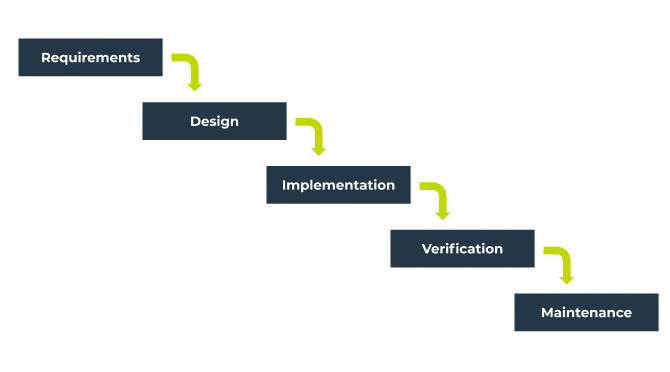
This style caters to those who seek an enhanced structuring of the project, but can be troublesome towards the latter half of the project in the event bugs and issues are found. These bugs and issues lead to lengthier project completion times, as steps completed earlier in the project must be revisited.
Agile Project Management
This style of project management is more versatile and modern than the waterfall model, making it a good choice for software development projects that require lots of flexibility and speed. Agile project management (Figure 3.2) sees developers working in smaller chunks that enable the project to pivot as necessary.
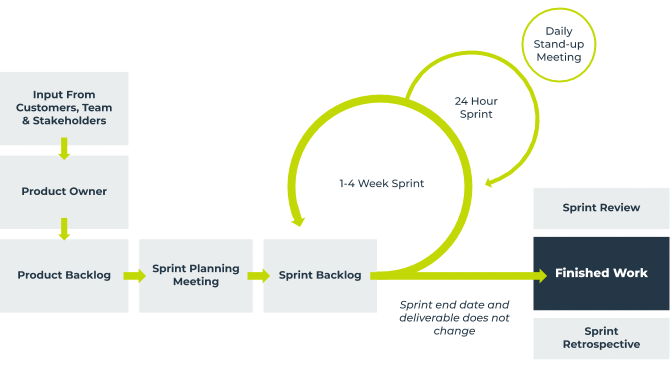
Scrum Project Management
Scrum project management (Figure 3.3) is a derivative of agile project management that prioritizes various tasks. A scrum master facilitates the process by putting together small teams that are given oversight of specific tasks. Projects that need to move quickly are good candidates for scrum project management as it breaks down projects into smaller pieces and uses sprints to accomplish them.
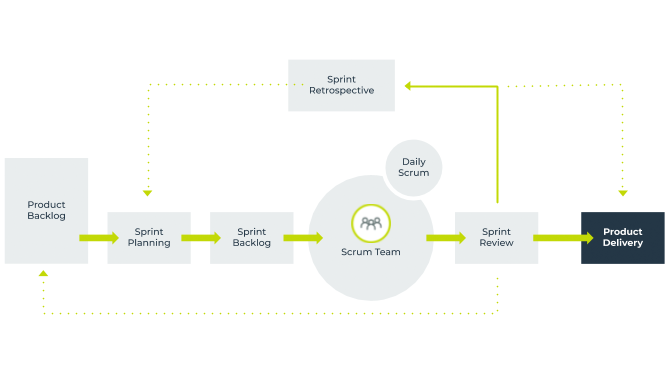
Kanban Project Management
Kanban (Figure 3.4) is a variation of agile project management which is focused on organization. It looks at the number of tasks that must be completed overall and considers how they can be reduced or streamlined. Although it can be applied to many types of projects, it is particularly good for those with an output that does not tend to vary.
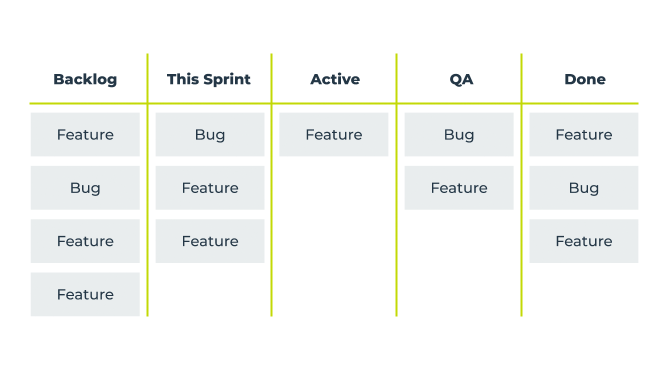
Lean Project Management
Like Kanban, lean project management (Figure 3.5) also focuses on the process, but it is mainly concerned with “trimming the fat”. It uses a customer-minded approach to determine how processes can be distilled in order to provide the most affordable and time-efficient customer experience. It also gives clients greater control over the results.
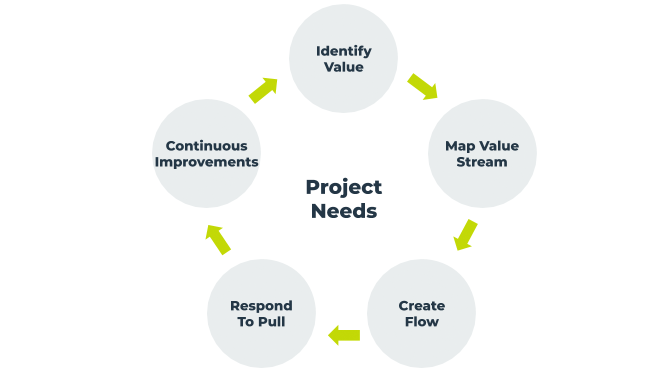
Six Sigma Project Management
With the Six Sigma method (Figure 3.6), improving quality is the main focus. Many companies turn to Six Sigma after not getting the results they wanted from the lean management style given its emphasis on giving customers the best end result possible. It can also be used in conjunction with other styles of management or for refining further after a different approach was used.
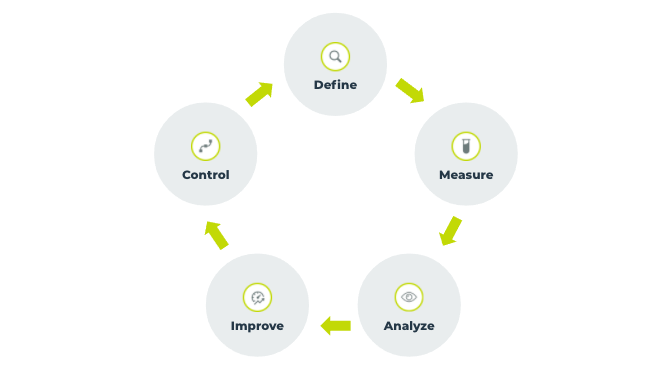
PRINCE2 Project Management
Thanks to its focus on minimizing errors and risks while maximizing efficiency, the PRINCE2 method (Figure 3.7) is favored by private sectors in the government. It divides projects into product-based steps so they can be tackled one at a time. This allows for more attention to detail to ensure that every base is covered.
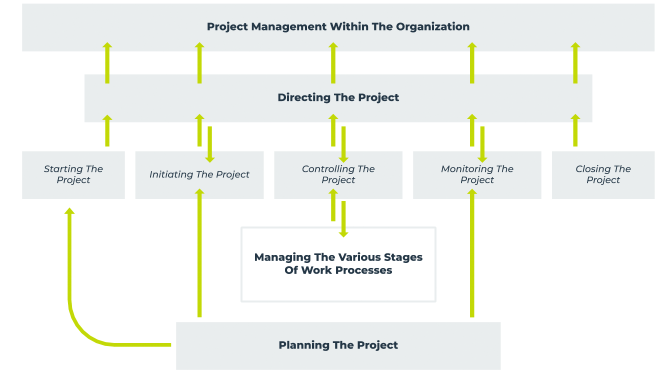
How To Avoid A Bad Custom Software Development Team
Hiring a custom software development company can be complicated. The process of building successful software requires not only the right mix of skill, coordination and understanding of the task at hand on the part of the developer, but also your ability to communicate what you need effectively.
The end result of your custom software pursuit will be directly influenced by the quality of your custom software development team, but how you work together also plays an important role. One of the biggest factors impacting success here is trust.
A project will only gain momentum and efficiency when all the parties involved trust one another, and a strong alignment of culture and character is essential in this regard. When you feel as though you worked together in-house with your software development team, you are more likely to be happy with the outcome.
Research Company’s Portfolio & Customers
The time you spend researching software development companies will be well spent as it can help you avoid a mismatch that leads to time-consuming and expensive mistakes and misunderstandings.
Start with referrals from your network if possible as this allows you to get some unbiased reviews. Once you have a list of contenders, take a look at their website to see if it is on point. You can tell a lot about a company by looking at their website. A high-quality website can indicate the company pays attention to detail, which is certainly a quality you will want your software developers to possess. Their blog may provide insight into whether they are thought leaders in the industry as well as whether your philosophies align with theirs.
Be sure to check out their portfolios to see if their products make a good impression. Look for in-depth projects rather than just a list of brand names that they have worked with in the past. Make sure any high-profile clients they mention actually hired them; some simply list mock case studies on their website in order to lend it some prestige.
In addition, websites such as Clutch[4] and Techreviewer[5] are highly credible sources for consumers searching for qualified custom software development companies.
View Orases’ Clutch ReviewsBecause trust and collaboration are such important elements in the software development process, it is a good idea to interview the developers you are considering to get a feel for how well you will work together. Trust your instincts, and do not hire anyone who you feel uncomfortable communicating with or who does not seem to understand what you are trying to convey.

Make Sure They Have Done Similar Projects Before
A software development company may be excellent at what they do, but that does not necessarily mean they are the best choice for your company. Find out whether they have carried out projects that are similar to yours in the past and how well they turned out.
If possible, ask these clients if they were happy with their work and if there is anything they wish they could change about their experience. If they cite some minor issues, it does not necessarily mean you should move on, but this can serve as valuable guidance when outlining your expectations.
“Is Their Software Stack Future Proof & Industry Friendly?” AVOID VENDOR LOCK-IN
Vendor lock-ins are restrictions that stop users from switching a service or software. This is a problem you will want to avoid with your custom software. Ensure that you will be able to migrate data from one technology stack to another as some will make it difficult for their users to move to a competitor’s stack.
Two of the most common software stacks used during development are LAMP & MEAN.

LAMP (Linux, Apache, MySQL, PHP) is often used by web developers because the components are open source and the entire stack can be used with commodity hardware. Most Linux distributions these days include LAMP components.

MEAN (MongoDB, Express, Angular, Node) is a free and open-source JavaScript stack that helps overcome programming language barriers encountered while developing dynamic custom software.
When purchasing custom software, be sure to ask about the stack and ensure one is chosen that another development team would easily be able to work on in the future should you switch vendors.
04
Chapter 04
What To Expect During The Custom Software Development Life Cycle
The software development life cycle is the process of producing software that offers maximum quality as quickly and cost-effectively as possible.
The custom software development life cycle is the process of producing software that offers maximum quality as quickly and cost-effectively as possible. The life cycle provides a set flow of phases to help organizations develop software that is ready for use, from the ideation phase to the product’s delivery.
It has evolved in the years since the invention of the computer and now provides a very clear path to help all parties involved to reach their software goals. The life cycle has a strong emphasis on the software testing phase to ensure high-quality code and eliminate the need for extra work later.
It is considered a cycle in the sense that it is ongoing; after the first release of a software product, there may be extra features or bug fixes that need to be designed, developed and deployed using the same processes that applied to the first release of the software itself.
When it is carried out correctly, the software development life cycle ensures the entire process runs smoothly, with developers having a clear sense of what needs to be built and companies understanding exactly what they will get. It will leave everyone understanding the costs, time and resources required and ensure quality output.
Communication (Hint, It Is Based On The Project Management Style)
Every project starts with a vision, and successfully conveying that to the software development team is the best way to ensure you get exactly what you want. Of course, that is only the beginning; productive communication throughout the project is essential for a satisfactory outcome.
This ties back to the project management style; finding out how the company will communicate their progress and any problems that arise can save a lot of trouble and conflict later. It is also important to discuss how any questions will be handled and to whom they should be directed.
Design
Your custom software development team will discuss your goals with you, including any functions you are not currently able to carry out but would like to add to your repertoire. You will also outline the primary audience for your initiative and what defines these audiences. Providing information about your competitors can also help inform the design stage.

The custom software development team will then carry out an assessment to determine the available resources, estimate the work involved and come up with a reasonable timeline to give your business a clear idea of when to expect deliverables.
Agreeing Upon The MVP & Sticking To It
Your custom software development team will develop a minimum viable product, or MVP, to give your organization an idea of what they can expect from the project when it is completed.
Although the software might have certain facets that still need further refinement, this is the version of the product that could technically go live immediately if needed.
At this stage, stakeholders will have the chance to propose any changes or new ideas before the developers get to work on developing the software. Once the MVP has been agreed upon, all parties are expected to stick to it.
Steps To Creating An MVP

In short, it refers to the essentials that the project must have when it is completed, while anything beyond the MVP would be considered nice to have but not necessarily indispensable. View The Advantages Of An MVP
Initial Costs & Ongoing Costs
The development team will provide an estimate of the cost of the project up front, including the initial costs and expected ongoing costs.
The upfront costs include the software project’s initial design, development, testing and deployment. Several factors can influence the cost of software development, especially the initial price.
The first is the complexity of the project, which includes the number and complexity of features that the software will include. The design also contributes to the cost, with more complex designs often costing more but coming with the added benefit of making the software more pleasant for users.
The platforms that the software needs to work on and the presence of a mobile app are also reflected in the price, along with the development team’s size and location.
However, software is never fully complete, even when the minimum viable product has been delivered. There is the potential to add new features, fix bugs and improve performance over time. Ongoing costs might include newer software versions, new functionalities, additional users and patches. Other ongoing costs include security, support, ongoing training and scaling to meet the needs of the business as it grows.
In addition, legal considerations and ownership agreements will also be discussed. Your company and the software developers will sign a non-disclosure agreement to protect your proprietary and confidential information and outline the details of your ownership over the end result.
Ongoing Support
After the software has been created, the life cycle does not end. All software needs constant monitoring to ensure it runs properly. In some cases, infrastructure support will be bundled into a maintenance agreement. Security and patches often figure into ongoing support as well.
Debugging
Debugging is an important part of the process for identifying any errors or flaws in the program that can cause it to behave in unintended ways or provide incorrect results. Developers will review their code for any bugs and then correct them, but others might be discovered later after the software is in wide use.
Most software will undergo rigorous testing and quality assurance procedures to ensure the final product runs smoothly and as expected. This includes unit testing, performance testing, integration testing and security testing.
Retrospecting
A retrospective is a meeting held at the end of a software development iteration in which the team looks back on what happened to find ways they can make improvements moving forward.
This is especially important in Agile software development, which stresses the importance of continuous improvement via reflection at regular intervals on how to become more effective and then adjusting behavior accordingly.
The team members will consider what worked well and what did not work, as they look for changes that could be made in the next iteration. It is a collaborative event, with members of the team deciding together on the best way to proceed.
Once again, an atmosphere of trust is essential so that everyone involved will feel comfortable sharing their opinions about the work. The retrospecting may include the sharing of data and insights, identifying high-priority items and putting measurable goals in place to reach them, and acknowledging the accomplishments of the team.

Custom software development projects, as promising as they always seem, ultimately rely on successfully navigating and implementing the definition, development, and delivery process to create them. To ensure the success of the project, download this 8 step guide for a successful custom software project!
Start Your Custom Software Project Today!
Custom software can bring your business’s efficiency to new heights and have a noticeable impact on your bottom line. However, to ensure a successful outcome, there are a few tips to keep in mind.
Hiring a software developer may automatically put you in a customer/supplier mindset, but viewing the process as a team effort can make it far more fruitful. Clearly establishing how the different stakeholders fit in and which SMEs are in charge of each part of the project can improve communication and accountability.
Although the process of developing custom software is a complex one, custom software development companies like Orases have the expertise and experience needed to carry out projects of all sizes successfully.


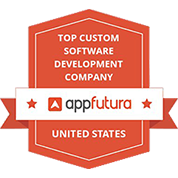
Their award-winning solutions are based on a deep understanding of your business. Their client-focused, trust-based approach has proven to be a successful one, as evidenced by their 96 percent client retention rate. Based in Frederick, Maryland, they have developed a broad range of custom projects across a variety of industries, cementing their position as innovators in the field.
Orases custom software development can bring your ideas to life quickly and efficiently to give you a competitive edge, freeing you up to focus on growing your business.
Schedule A Custom Software Consultation
"*" indicates required fields















